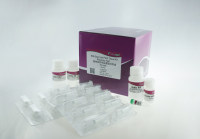谷类植物种子蛋白质提取
丁香园
7088
1. 前言
从种子中提取蛋白质一般没有太多困难。但是,要想成功提取,这一步就要格外小心,因为种子并不是一种组织构成。不同物种的种子成分有很大差异。受精后,细胞分裂产生不同的组织,如胚乳、胚 、胚盘、子叶、糊粉层及种皮,每一种组织都有不同的生化成分。像大多数的植物组织,种子也含有不同的成分,这些成分会严重地减少蛋白质的提取量,或者严重干扰蛋白质在双向电泳中的分离。种子的外层通常由半纤维素、木酚素、多酸及阿拉伯木聚糖构成。多种植物的细胞壁都是由阿拉伯木聚糖,阿拉伯半乳聚糖构成。种子一般可看成各种成分的贮藏所,其中一些组织能够富集多糖、脂质及许多次生代谢物,这些组织通常蛋白质含量少,蛋白酶类却很多 [ 1] 。要成功提取种子中的蛋白质,在溶解蛋白质进行电泳分析时 [2] ,要根据一定的原则,避免双向电泳中的异常变化,如垂直拖尾(vertical streaking) 、弥散、可辨认蛋白质点的数量减少等。对于谷类植物种子来讲,主要的贮藏成分是淀粉和复合碳水化合物(图 3-1),这些物质会对蛋白质的提取带来不便。
种子中存在的许多蛋白质,通常能根据它们在不同溶剂中的溶解度分为 4 类 ,这些溶剂依次加入,用于提取不同蛋白质 [ 3] 。在研磨成粉末的种子中,白蛋白是水溶性蛋白质 ,而球蛋白必须加入 NaCl 溶液提取。相对于谷类植物子粒中的贮藏蛋白质,这些蛋白质都是可溶的。白蛋白和球蛋白在谷类植物种子中分别占全部蛋白质含量的 10%,在豆科植物中占全部蛋白质含量的 85% 以上 [ 4] 。贮藏蛋白质首先分为醇溶蛋白和谷蛋白。这两种蛋白都是疏水性的,常聚集在液泡里或者形成蛋白质体。醇溶蛋白,如麦醇溶蛋白、大麦醇蛋白、玉米醇蛋白、燕麦醇蛋白和水稻醇蛋白(分别来自小麦、大麦、玉米、燕麦和水稻)都是单体且溶于 70% 的乙醇。谷蛋白(小麦中的谷蛋白)通常是聚合在一起的,并可以用含有还原剂的酸性溶剂提取出来。两种贮藏蛋白(醇蛋白和麦谷蛋白)都富含脯氨酸和谷氨酰胺,归为醇蛋白类 [5] ,其他特殊溶剂现在也被用于提取贮藏蛋白 [ 6~8]。
因为植物物种不同,并非所有种子中的蛋白质都可以被全部提取。选择一种提取方法时,往往要考虑多种因素。因为蛋白质不是种子中的主要成分,它们常和其他成分聚集或结合到一起,如细胞壁物质或者是淀粉粒,或者由于研磨颗粒粗糙而使蛋白不易溶解出来。后者在谷类植物中至关重要,因为谷类植物的遗传因素可以影响籽粒中胚乳的坚硬度,并由此影响是否能够研磨充分。种子是否能充分而一致地研磨会直接影响蛋白质提取的重复性。种子中的水分也会影响研磨后的均一程度,所以所有的材料在取样时需要保持恒定的湿度。此外,种子即使是纯合体且基因型一致,由于所在穗、荚和花序上等的位置不同,其年龄可能并不相同。举例来说,在一棵小麦穗上,中部到末梢所有花受精需要 2~3 天,结果造成籽粒的大小不同,组织中蛋白质成分含量也不同。
下面介绍一些用于提取蛋白质的经典方法。分两类:① 普适方法,这种方法是用合适的提取缓冲液提取种子中主要的蛋白质;② 这种方法更加适用于谷类植物蛋白质,可以分别提取 4 种蛋白质,另外还有一种淀粉粒中的蛋白质。
2. 材料
所有的化学药品都为分析纯。
2.1 用于提取种子总蛋白的普适方法
( 1 ) 提取液:10% ( V/V ) 三氯乙酸用预冷丙酮稀释,0.07% ( V/V ) β-巯基乙醇丙酮溶液和 0.4% ( V/V ) 植物蛋白酶抑制剂(Sigma、Steinheim、Germany , cat. no.P 9599 )。这种溶液叫三氯乙酸/丙酮提取液,-20°C 保存。
( 2 ) 漂洗液:沉淀蛋白质在预冷丙酮中漂洗,丙酮里加入和上述提取液一样的成分,但是不加三氯乙酸,-20°C 保存。
( 3 ) 溶解液:7 mol/L 尿素,2 mol/L 硫脲,4% ( m/V ) 3- [ 3 - ( 胆酰胺丙基)二甲氨基 ] 丙磺酸内盐(CHAPS) ,2% ( m/V ) 二硫苏糖醇(DTT ) ,0.4% ( V/V ) 蛋白酶抑制剂(Sigma),1% ( V/V ) 载体两性电解质 pH 3~10 和 1% ( V/V)载体两性电解质 pH 6~9.5 [ 或 4~7、或 6~11,根据等电聚焦(IEF)步骤中 IPG 条梯度] ( 见注释 1 和注释 2 )。
( 4 ) 烧化剂:4-乙烯基吡啶(Aldrich,cat. no. V3,40-4)。
( 5 ) 甘油溶液:60% ( V/V)甘油用水稀释,加入痕量溴酚蓝。
( 6 ) 蛋白质浓度测定:用考马斯亮蓝法(bradford assay ) ( Sigma,cat. no.B6916 ) 或 2D Quant 试剂盒(Amersham,cat.No. 80 6483 56) ,用牛血清白蛋白 ( BSA ) 作为蛋白质标准品。
2.2 特殊蛋白质的提取
1. 白蛋白和球蛋白
( 1 ) 磷酸钠缓冲液:50 mmol/L 磷酸钠缓冲液,pH 7.8;0.1 mol/L NaCl 含有 0.4% ( V/V ) 蛋白酶抑制剂(Sigma ) 。可以在 4°C 保存 4 周。
( 2 ) 透析:透析用 Slide-A-lyzer 透析暗盒,7 K MWCO,0.1~0.5 ml 容量 ( Pierce, www.piercenet.com ) 。
2. 两性蛋白质
( 1 ) Tris-HCl 缓冲液:0.1 mol/L Tris、5 mmol/L EDTA、0.25 mol/L NaCl 用 HCl 调至 pH 7.8。保存在 4°C 条件下数周。
( 2 ) Triton X-114 溶液:加 2% ( V/V) Triton X-114 和 0.4%(V/V)蛋白酶抑制剂(Sigma ) 到 Tris-HCl 缓冲液。这种 Triton 溶液应该在使用前准备。
( 3 ) 沉淀液:1 体积二乙醚和 3 体积乙醇,在使用之前在通风橱里准备好。
3. 淀粉粒蛋白质
整个操作流程都使用去离子水。
( 1 ) 密度梯度:90% (V/V) 氯化铯(CsCl,Prolabo) 。
( 2 ) 漂洗液:4% ( m/V ) CHAPS 和 2% ( m/V)DTT。
4. 注释
( 1 ) 最常使用的还原剂是 DTT,不过选择还原剂要根据样品特点,所以三丁基膦 ( TBP ) 也可使用 [ 25 ] 。
( 2 ) 溶液应该在使用前准备,或者分装保存在 -80°C。
( 3 ) TCA 能够强烈影响蛋白质折叠和沉淀,阻止蛋白质的溶解。因此在提取缓冲液中不用 TCA。
( 4 ) 20 mmol/L DTT 可以用来代替 0.07% β-巯基乙醇作为还原剂。
( 5 ) 推荐使用植物蛋白酶抑制剂。它的使用可以使一些材料在零上温度条件下进行涡旋和超声处理(20W、20s) 。
( 6 ) 尽管 TCA/丙酮方法可以使蛋白质浓缩,但要想让低分子质量的蛋白质沉淀下来 ,则需要更高标准的离心参数(如 30000 g、4°C 离心 30 min) 。
( 7 ) 蛋白质沉淀可以晾干并在 -80°C 保存,或者不进行保存直接进行再溶解。
( 8 ) 当用绿熟材料或绿熟籽粒时,可以先用液氮冷冻,之后用研钵和杵在液氮中捣碎。
( 9 ) 材料也可以被冻干并保存在 -20°C 直到用于分析。
( 10 ) 若样品是成熟的谷类植物籽粒,籽粒可用 Cyclotec 1920 磨粉机(Tecator、Hoganas、Sweden) 配上 0.75 mm 网筛研磨。粉末必须立即提取蛋白。
( 11 ) 自由巯基的烷化可以用 2- 碘乙酰胺代替 4-乙烯基吡陡。烷化通常只在 IEF 之后在 IPG 胶条平衡步骤中完成。巯基烷化后,贮藏蛋白的亚基将会更好地分离。
( 12 ) 甘油溶液优先考虑在杯中上样,此外,在等电聚焦之前的水化过程中一直存在 。在有些等电聚焦分离过程中可以除去甘油溶液,如白蛋白和球蛋白的分离。
( 13 ) 白蛋白或是其他水溶性蛋白可以用预冷蒸馏水直接提取,如拟南芥的种子 [ 16] 。
( 14 ) 由于丙酮沉淀可以除去盐分,所以透析步骤可省略,特别是当少量蛋白质用于 IEF 时。当需要大量(>150 μg)蛋白质上样时,透析可以除去提取液中干扰物质,避免第一向等电聚焦水平拖尾。
( 15 ) 相分配可以使两性蛋白质富集到下层高密度相中。轻相应该小心地移出,因为发现许多蛋白质存在于较轻相和较重相的中间。
( 16 ) 淀粉粒能够从 1~2 个或者更多的无胚籽粒中被分离出来。此外,种子可以被切割成半并保留用于形成幼苗的胚部分。用于提取存在于淀粉粒中或强力吸附于淀粉粒上的蛋白质的淀粉粒的量可高于 40 mg。这个量对于用银染 2-DE 凝胶检测小麦淀粉粒中的主要蛋白质是足够的。最近在大麦上采用了类似的方法 [ 26] 。这个量对于小麦淀粉粒而言,用银染的方法足够能检测到它所包含的主要蛋白质。
参考文献
1. Tsugita, A. and Kamo, M. (1999) 2D Electrophoresis of plant proteins. MethodsMol. Biol. 112, 95-97.
2 . Rabilloud, T. (1996) Solubilization of proteins for electrophoretic analyses. Electrophoresis 17, 813-829.
3. Osborne, T. B. (1907) The proteins of the wheat kernel. Publication o f theCarnegie Institution, Washington,^/ashington,DC.
4. Gueguen, J. and Lemarie, J. (1996) Composition, structure et proprietes physico-chimiques des proteins de legumineuses et d'oleagineux, in Proteines Vegetales(Godon, B. E., ed.), Lavoisier, Paris, pp. 80-119.
5. Shewry, P. R., Tatham, A. S., Forde, J., Kreis, M., and Miflin, B. J. (1986) Theclassification and nomenclature of wheat gluten proteins: a reassessment. J. CerealSci. 4, 97-106.
6. Marion, D., Nicolas, Y., Popineau, Y., Branlard, G., and Landry, J. (1994) A newimproved sequential extraction procedure of wheat proteins, in Wheat KernelProteins-Molecular and Functional Aspects.Universita Degli Studi della TusciaConsiglio Nationale delle Ricerche, pp. 197-199.
7. Fu, B. X. and Kovacs, M. I. P. (1999) Rapid single-step procedure for isolatingtotal glutenin proteins of wheat flour. J. Cereal Sci. 29, 113-116.
8 . Landry, J., Delaye, S., and Damerval, C (2000) Improved method for isolating andquantitating a-amino nitrogen as nonprotein, true protein, salt-soluble proteins,zeins, and true glutelins in maize endosperm. Cereal Chem.77, 620-626.
9. Damerval, C., de Vienne, D., Zivy, M., and Thiellement, H. (1986) Technicalimprovements in two-dimensional electrophoresis increase the level of geneticvariation detected in wheat-seedling proteins. Electrophoresis7, 52-54.
10 . Granier, F. (1988) Extraction of plant proteins for two-dimensional electrophoresis. Electrophoresis 9,71 2-718.
11. Islam, N., Tsujimoto, H., and Hirano, H. (2003) Proteome analysis of diploid,tetraploid and hexaploid wheat: towards understanding genome interaction inprotein expression. 尸 3, 549-557.
12 . Vensel, W. H., Tanaka, C. K., Cai, N., Wong, J. H., Buchanan, B. B., and Hurkman,W. J. (2005) Developmental changes in the metabolic protein profiles of wheatendosperm. Proteomics 5 , 1594-1611.
13. Wong, J. H., Cai, N., Balmer, Y., et al. (2004) Thioredoxin targets of developingwheat seeds identified by complementary proteomic approaches. Phytochemistry6 5 , 1629-1640.
14 . 0stergaard, 0 ., Melchior, S., Roepstorff, P., and Svensson, B. (2002) Initialproteome analysis of mature barley seeds and malt. Proteomics 2,733-739.
15. 0sterggard, 0 ., Finnie, C., Laugesen, S., Roepstorff, P., and Svensson, B. (2004)Proteome analysis of barley seeds: identification of major proteins from two-dimensional gels (pi 4-7). P r o te o m ic s 4, 2437-2447.
16. Gallardo, K., Job, C., Groot, S. P. C., et al. (2001) Proteomic analysis ofarabidopsis seed germination and priming.126, 835-848.
17. Bradford, M.M. (1976) A rapid and sensitive method for the quantitation of microgram quantities of protein utilizing the principle of protein-dye binding. A n a l.B io c h e m .72, 248-254.
18 . Nicolas, Y., Martinant, J. P., Denery-Papini, S., and Popineau, Y. (1998) Analysisof wheat storage proteins by exhaustive sequential extraction followed byRP-HPLC and nitrogen determination. J. S ci. F o o d A g r ic .77, 96-102.
19 . Majoul, T., Bancel, E., Triboi, E., Ben Hamida, J., and Branlard, G. (2004)Proteomic analysis of the effect of heat stress on hexaploid wheat grain: characterization of heat-responsive proteins from non-prolamins fraction. P r o te o m ic s 4,505-513.
20. Blochet, J. E., Kaboulou, A., Compoint, J. P., and Marion, D. (1991) Amphiphilicproteins from wheat flour: specific extraction, structure and lipid binding properties, in G lu te n P r o te in s 1 9 9 0 (Bushuk, W. and Tkachuk, R., eds.), American Association of Cereal Chemistry, St. Paul, MN, pp. 314-325.
21. Branlard, G., Amiour, N., Igrejas, G., et al. (2003) Diversity of puroindolines asrevealed by two-dimensional electrophoresis. P r o te o m ic s 3,168-174.
22. Amiour, N., Merlino, M., Leroy, P., and Branlard, G. (2002) Proteomic analysis ofamphiphilic proteins of hexaploid wheat. P r o te o m ic s 2, 632-641.
23. Zhao, X.C. and Sharp, P.J. (1996) An improved 1-D SDS-PAGE method for theidentification of three bread wheat uwaxyJ, proteins. J. C e r e a l S ci. 23, 191-193.
24. Marcoz-Ragot, C., Gateau, I., Koenig, J., Delaire, V., and Branlard, G. (2000)Allelic variants of granule-bound starch synthase proteins in European bread wheatvarieties. P la n t B r e e d in g 119, 305-309.
25. Skylas, D. J., Mackintosh J. A., Cordwell, S. T., et al. (2000) Proteome approach tothe characterisation of protein composition in the developing and mature wheat-grain endosperm. J . C e r e a l S ci. 32, 169-188.
26. Borel, M., Larsson, H., Falk, A., and Jansson, C. (2004) The barley starch granuleproteome-internalized granule polypeptides of the mature endosperm. P la n t Sci.166,617-626.
从种子中提取蛋白质一般没有太多困难。但是,要想成功提取,这一步就要格外小心,因为种子并不是一种组织构成。不同物种的种子成分有很大差异。受精后,细胞分裂产生不同的组织,如胚乳、胚 、胚盘、子叶、糊粉层及种皮,每一种组织都有不同的生化成分。像大多数的植物组织,种子也含有不同的成分,这些成分会严重地减少蛋白质的提取量,或者严重干扰蛋白质在双向电泳中的分离。种子的外层通常由半纤维素、木酚素、多酸及阿拉伯木聚糖构成。多种植物的细胞壁都是由阿拉伯木聚糖,阿拉伯半乳聚糖构成。种子一般可看成各种成分的贮藏所,其中一些组织能够富集多糖、脂质及许多次生代谢物,这些组织通常蛋白质含量少,蛋白酶类却很多 [ 1] 。要成功提取种子中的蛋白质,在溶解蛋白质进行电泳分析时 [2] ,要根据一定的原则,避免双向电泳中的异常变化,如垂直拖尾(vertical streaking) 、弥散、可辨认蛋白质点的数量减少等。对于谷类植物种子来讲,主要的贮藏成分是淀粉和复合碳水化合物(图 3-1),这些物质会对蛋白质的提取带来不便。
种子中存在的许多蛋白质,通常能根据它们在不同溶剂中的溶解度分为 4 类 ,这些溶剂依次加入,用于提取不同蛋白质 [ 3] 。在研磨成粉末的种子中,白蛋白是水溶性蛋白质 ,而球蛋白必须加入 NaCl 溶液提取。相对于谷类植物子粒中的贮藏蛋白质,这些蛋白质都是可溶的。白蛋白和球蛋白在谷类植物种子中分别占全部蛋白质含量的 10%,在豆科植物中占全部蛋白质含量的 85% 以上 [ 4] 。贮藏蛋白质首先分为醇溶蛋白和谷蛋白。这两种蛋白都是疏水性的,常聚集在液泡里或者形成蛋白质体。醇溶蛋白,如麦醇溶蛋白、大麦醇蛋白、玉米醇蛋白、燕麦醇蛋白和水稻醇蛋白(分别来自小麦、大麦、玉米、燕麦和水稻)都是单体且溶于 70% 的乙醇。谷蛋白(小麦中的谷蛋白)通常是聚合在一起的,并可以用含有还原剂的酸性溶剂提取出来。两种贮藏蛋白(醇蛋白和麦谷蛋白)都富含脯氨酸和谷氨酰胺,归为醇蛋白类 [5] ,其他特殊溶剂现在也被用于提取贮藏蛋白 [ 6~8]。
因为植物物种不同,并非所有种子中的蛋白质都可以被全部提取。选择一种提取方法时,往往要考虑多种因素。因为蛋白质不是种子中的主要成分,它们常和其他成分聚集或结合到一起,如细胞壁物质或者是淀粉粒,或者由于研磨颗粒粗糙而使蛋白不易溶解出来。后者在谷类植物中至关重要,因为谷类植物的遗传因素可以影响籽粒中胚乳的坚硬度,并由此影响是否能够研磨充分。种子是否能充分而一致地研磨会直接影响蛋白质提取的重复性。种子中的水分也会影响研磨后的均一程度,所以所有的材料在取样时需要保持恒定的湿度。此外,种子即使是纯合体且基因型一致,由于所在穗、荚和花序上等的位置不同,其年龄可能并不相同。举例来说,在一棵小麦穗上,中部到末梢所有花受精需要 2~3 天,结果造成籽粒的大小不同,组织中蛋白质成分含量也不同。
下面介绍一些用于提取蛋白质的经典方法。分两类:① 普适方法,这种方法是用合适的提取缓冲液提取种子中主要的蛋白质;② 这种方法更加适用于谷类植物蛋白质,可以分别提取 4 种蛋白质,另外还有一种淀粉粒中的蛋白质。
2. 材料
所有的化学药品都为分析纯。
2.1 用于提取种子总蛋白的普适方法
( 1 ) 提取液:10% ( V/V ) 三氯乙酸用预冷丙酮稀释,0.07% ( V/V ) β-巯基乙醇丙酮溶液和 0.4% ( V/V ) 植物蛋白酶抑制剂(Sigma、Steinheim、Germany , cat. no.P 9599 )。这种溶液叫三氯乙酸/丙酮提取液,-20°C 保存。
( 2 ) 漂洗液:沉淀蛋白质在预冷丙酮中漂洗,丙酮里加入和上述提取液一样的成分,但是不加三氯乙酸,-20°C 保存。
( 3 ) 溶解液:7 mol/L 尿素,2 mol/L 硫脲,4% ( m/V ) 3- [ 3 - ( 胆酰胺丙基)二甲氨基 ] 丙磺酸内盐(CHAPS) ,2% ( m/V ) 二硫苏糖醇(DTT ) ,0.4% ( V/V ) 蛋白酶抑制剂(Sigma),1% ( V/V ) 载体两性电解质 pH 3~10 和 1% ( V/V)载体两性电解质 pH 6~9.5 [ 或 4~7、或 6~11,根据等电聚焦(IEF)步骤中 IPG 条梯度] ( 见注释 1 和注释 2 )。
( 4 ) 烧化剂:4-乙烯基吡啶(Aldrich,cat. no. V3,40-4)。
( 5 ) 甘油溶液:60% ( V/V)甘油用水稀释,加入痕量溴酚蓝。
( 6 ) 蛋白质浓度测定:用考马斯亮蓝法(bradford assay ) ( Sigma,cat. no.B6916 ) 或 2D Quant 试剂盒(Amersham,cat.No. 80 6483 56) ,用牛血清白蛋白 ( BSA ) 作为蛋白质标准品。
2.2 特殊蛋白质的提取
1. 白蛋白和球蛋白
( 1 ) 磷酸钠缓冲液:50 mmol/L 磷酸钠缓冲液,pH 7.8;0.1 mol/L NaCl 含有 0.4% ( V/V ) 蛋白酶抑制剂(Sigma ) 。可以在 4°C 保存 4 周。
( 2 ) 透析:透析用 Slide-A-lyzer 透析暗盒,7 K MWCO,0.1~0.5 ml 容量 ( Pierce, www.piercenet.com ) 。
2. 两性蛋白质
( 1 ) Tris-HCl 缓冲液:0.1 mol/L Tris、5 mmol/L EDTA、0.25 mol/L NaCl 用 HCl 调至 pH 7.8。保存在 4°C 条件下数周。
( 2 ) Triton X-114 溶液:加 2% ( V/V) Triton X-114 和 0.4%(V/V)蛋白酶抑制剂(Sigma ) 到 Tris-HCl 缓冲液。这种 Triton 溶液应该在使用前准备。
( 3 ) 沉淀液:1 体积二乙醚和 3 体积乙醇,在使用之前在通风橱里准备好。
3. 淀粉粒蛋白质
整个操作流程都使用去离子水。
( 1 ) 密度梯度:90% (V/V) 氯化铯(CsCl,Prolabo) 。
( 2 ) 漂洗液:4% ( m/V ) CHAPS 和 2% ( m/V)DTT。
4. 注释
( 1 ) 最常使用的还原剂是 DTT,不过选择还原剂要根据样品特点,所以三丁基膦 ( TBP ) 也可使用 [ 25 ] 。
( 2 ) 溶液应该在使用前准备,或者分装保存在 -80°C。
( 3 ) TCA 能够强烈影响蛋白质折叠和沉淀,阻止蛋白质的溶解。因此在提取缓冲液中不用 TCA。
( 4 ) 20 mmol/L DTT 可以用来代替 0.07% β-巯基乙醇作为还原剂。
( 5 ) 推荐使用植物蛋白酶抑制剂。它的使用可以使一些材料在零上温度条件下进行涡旋和超声处理(20W、20s) 。
( 6 ) 尽管 TCA/丙酮方法可以使蛋白质浓缩,但要想让低分子质量的蛋白质沉淀下来 ,则需要更高标准的离心参数(如 30000 g、4°C 离心 30 min) 。
( 7 ) 蛋白质沉淀可以晾干并在 -80°C 保存,或者不进行保存直接进行再溶解。
( 8 ) 当用绿熟材料或绿熟籽粒时,可以先用液氮冷冻,之后用研钵和杵在液氮中捣碎。
( 9 ) 材料也可以被冻干并保存在 -20°C 直到用于分析。
( 10 ) 若样品是成熟的谷类植物籽粒,籽粒可用 Cyclotec 1920 磨粉机(Tecator、Hoganas、Sweden) 配上 0.75 mm 网筛研磨。粉末必须立即提取蛋白。
( 11 ) 自由巯基的烷化可以用 2- 碘乙酰胺代替 4-乙烯基吡陡。烷化通常只在 IEF 之后在 IPG 胶条平衡步骤中完成。巯基烷化后,贮藏蛋白的亚基将会更好地分离。
( 12 ) 甘油溶液优先考虑在杯中上样,此外,在等电聚焦之前的水化过程中一直存在 。在有些等电聚焦分离过程中可以除去甘油溶液,如白蛋白和球蛋白的分离。
( 13 ) 白蛋白或是其他水溶性蛋白可以用预冷蒸馏水直接提取,如拟南芥的种子 [ 16] 。
( 14 ) 由于丙酮沉淀可以除去盐分,所以透析步骤可省略,特别是当少量蛋白质用于 IEF 时。当需要大量(>150 μg)蛋白质上样时,透析可以除去提取液中干扰物质,避免第一向等电聚焦水平拖尾。
( 15 ) 相分配可以使两性蛋白质富集到下层高密度相中。轻相应该小心地移出,因为发现许多蛋白质存在于较轻相和较重相的中间。
( 16 ) 淀粉粒能够从 1~2 个或者更多的无胚籽粒中被分离出来。此外,种子可以被切割成半并保留用于形成幼苗的胚部分。用于提取存在于淀粉粒中或强力吸附于淀粉粒上的蛋白质的淀粉粒的量可高于 40 mg。这个量对于用银染 2-DE 凝胶检测小麦淀粉粒中的主要蛋白质是足够的。最近在大麦上采用了类似的方法 [ 26] 。这个量对于小麦淀粉粒而言,用银染的方法足够能检测到它所包含的主要蛋白质。
参考文献
1. Tsugita, A. and Kamo, M. (1999) 2D Electrophoresis of plant proteins. MethodsMol. Biol. 112, 95-97.
2 . Rabilloud, T. (1996) Solubilization of proteins for electrophoretic analyses. Electrophoresis 17, 813-829.
3. Osborne, T. B. (1907) The proteins of the wheat kernel. Publication o f theCarnegie Institution, Washington,^/ashington,DC.
4. Gueguen, J. and Lemarie, J. (1996) Composition, structure et proprietes physico-chimiques des proteins de legumineuses et d'oleagineux, in Proteines Vegetales(Godon, B. E., ed.), Lavoisier, Paris, pp. 80-119.
5. Shewry, P. R., Tatham, A. S., Forde, J., Kreis, M., and Miflin, B. J. (1986) Theclassification and nomenclature of wheat gluten proteins: a reassessment. J. CerealSci. 4, 97-106.
6. Marion, D., Nicolas, Y., Popineau, Y., Branlard, G., and Landry, J. (1994) A newimproved sequential extraction procedure of wheat proteins, in Wheat KernelProteins-Molecular and Functional Aspects.Universita Degli Studi della TusciaConsiglio Nationale delle Ricerche, pp. 197-199.
7. Fu, B. X. and Kovacs, M. I. P. (1999) Rapid single-step procedure for isolatingtotal glutenin proteins of wheat flour. J. Cereal Sci. 29, 113-116.
8 . Landry, J., Delaye, S., and Damerval, C (2000) Improved method for isolating andquantitating a-amino nitrogen as nonprotein, true protein, salt-soluble proteins,zeins, and true glutelins in maize endosperm. Cereal Chem.77, 620-626.
9. Damerval, C., de Vienne, D., Zivy, M., and Thiellement, H. (1986) Technicalimprovements in two-dimensional electrophoresis increase the level of geneticvariation detected in wheat-seedling proteins. Electrophoresis7, 52-54.
10 . Granier, F. (1988) Extraction of plant proteins for two-dimensional electrophoresis. Electrophoresis 9,71 2-718.
11. Islam, N., Tsujimoto, H., and Hirano, H. (2003) Proteome analysis of diploid,tetraploid and hexaploid wheat: towards understanding genome interaction inprotein expression. 尸 3, 549-557.
12 . Vensel, W. H., Tanaka, C. K., Cai, N., Wong, J. H., Buchanan, B. B., and Hurkman,W. J. (2005) Developmental changes in the metabolic protein profiles of wheatendosperm. Proteomics 5 , 1594-1611.
13. Wong, J. H., Cai, N., Balmer, Y., et al. (2004) Thioredoxin targets of developingwheat seeds identified by complementary proteomic approaches. Phytochemistry6 5 , 1629-1640.
14 . 0stergaard, 0 ., Melchior, S., Roepstorff, P., and Svensson, B. (2002) Initialproteome analysis of mature barley seeds and malt. Proteomics 2,733-739.
15. 0sterggard, 0 ., Finnie, C., Laugesen, S., Roepstorff, P., and Svensson, B. (2004)Proteome analysis of barley seeds: identification of major proteins from two-dimensional gels (pi 4-7). P r o te o m ic s 4, 2437-2447.
16. Gallardo, K., Job, C., Groot, S. P. C., et al. (2001) Proteomic analysis ofarabidopsis seed germination and priming.126, 835-848.
17. Bradford, M.M. (1976) A rapid and sensitive method for the quantitation of microgram quantities of protein utilizing the principle of protein-dye binding. A n a l.B io c h e m .72, 248-254.
18 . Nicolas, Y., Martinant, J. P., Denery-Papini, S., and Popineau, Y. (1998) Analysisof wheat storage proteins by exhaustive sequential extraction followed byRP-HPLC and nitrogen determination. J. S ci. F o o d A g r ic .77, 96-102.
19 . Majoul, T., Bancel, E., Triboi, E., Ben Hamida, J., and Branlard, G. (2004)Proteomic analysis of the effect of heat stress on hexaploid wheat grain: characterization of heat-responsive proteins from non-prolamins fraction. P r o te o m ic s 4,505-513.
20. Blochet, J. E., Kaboulou, A., Compoint, J. P., and Marion, D. (1991) Amphiphilicproteins from wheat flour: specific extraction, structure and lipid binding properties, in G lu te n P r o te in s 1 9 9 0 (Bushuk, W. and Tkachuk, R., eds.), American Association of Cereal Chemistry, St. Paul, MN, pp. 314-325.
21. Branlard, G., Amiour, N., Igrejas, G., et al. (2003) Diversity of puroindolines asrevealed by two-dimensional electrophoresis. P r o te o m ic s 3,168-174.
22. Amiour, N., Merlino, M., Leroy, P., and Branlard, G. (2002) Proteomic analysis ofamphiphilic proteins of hexaploid wheat. P r o te o m ic s 2, 632-641.
23. Zhao, X.C. and Sharp, P.J. (1996) An improved 1-D SDS-PAGE method for theidentification of three bread wheat uwaxyJ, proteins. J. C e r e a l S ci. 23, 191-193.
24. Marcoz-Ragot, C., Gateau, I., Koenig, J., Delaire, V., and Branlard, G. (2000)Allelic variants of granule-bound starch synthase proteins in European bread wheatvarieties. P la n t B r e e d in g 119, 305-309.
25. Skylas, D. J., Mackintosh J. A., Cordwell, S. T., et al. (2000) Proteome approach tothe characterisation of protein composition in the developing and mature wheat-grain endosperm. J . C e r e a l S ci. 32, 169-188.
26. Borel, M., Larsson, H., Falk, A., and Jansson, C. (2004) The barley starch granuleproteome-internalized granule polypeptides of the mature endosperm. P la n t Sci.166,617-626.







